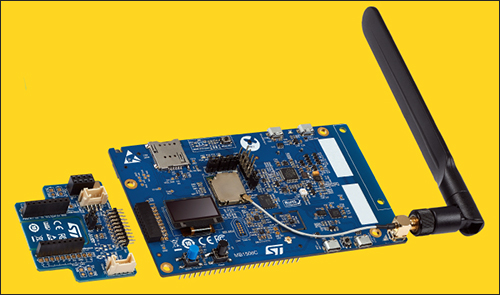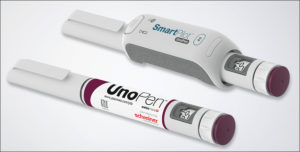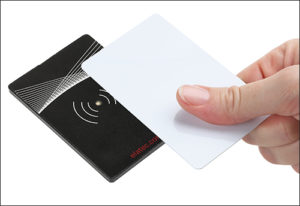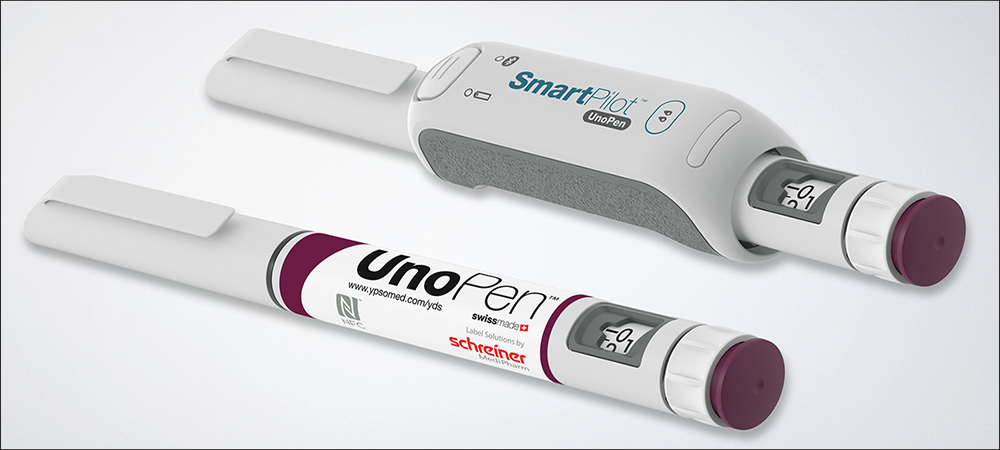Presented here are recent news announcements regarding the following organizations: Avery Dennison Smartrac, the Auburn University RFID Lab, STMicroelectronics, HID Global, Schreiner MediPharm, Ypsomed, Elatec, Intek, Minerva Associates, CipherLab, Johnson Controls and Pelion.
Avery Dennison Smartrac Intros RFID Inlays for Pharma
Avery Dennison Smartrac has released its Minidose U8 RFID inlays for pharmaceutical applications, which the company claims are the first products to receive ARC certification (Spec S) from Auburn University’s RFID Lab, and to be approved for use by DoseID. The inlays work with multiple items, the company reports, including syringes and both plastic and glass vials, as well as different drug packaging designs.
 The inlay operates in the standard UHF RFID frequency band of 860 and 960 MHz. It has a form factor of 22 millimeters by 12 millimeters (0.9 inch by 0.5 inch), is available in dry and wet formats, and comes with NXP Semiconductors‘ UCODE 8 IC chip. The product is expected to ship in volume during the second quarter of 2021 and is compliant with the ISO 9001:2015 Quality Management and ISO 14001:2015 Environmental Management standards.
The inlay operates in the standard UHF RFID frequency band of 860 and 960 MHz. It has a form factor of 22 millimeters by 12 millimeters (0.9 inch by 0.5 inch), is available in dry and wet formats, and comes with NXP Semiconductors‘ UCODE 8 IC chip. The product is expected to ship in volume during the second quarter of 2021 and is compliant with the ISO 9001:2015 Quality Management and ISO 14001:2015 Environmental Management standards.
“As the smallest product currently on the market that has passed ARC Spec S, Minidose U8 meets the needs of a wide range of pharmaceutical item-level packaging solutions,” said Hal Hikita, the head of product line management at Avery Dennison Smartrac, in a prepared statement. “The inlay is qualified to perform robustly on clear and amber glass, as well as plastics and syringes, even when filled with pharmaceuticals and biologicals, thereby unlocking critical RFID value for healthcare, pharmacies and laboratory asset management.”
STMicroelectronics Releases Cellular IoT Discovery Kit
STMicroelectronics has announced that its B-L462E-CELL1 Discovery Kit provides the necessary hardware and software, including GSMA-certified embedded SIM (eSIM), for users to develop cellular Internet of Things (IoT) devices that connect to the Internet via LTE-Cat M and NB-IoT networks. The kit is designed for embedded developers and IoT evangelists, the company reports, as well as for original equipment manufacturers and mass-market customers.
The Discovery Kit features a cellular module from Murata that embeds ST’s STM32L462 microcontroller, its ST4SIM-200M eSIM and an LTE-M/NB-IOT chipset. The eSIM is pre-programmed with a bootstrap connectivity profile from STMicroelectronics partner Truphone. The kit offers out-of-the-box data connectivity, the company reports, and enables remote SIM provisioning and over-the-air updates. Users can start the board by connecting to a power supply using a USB cable or inserting three AAA batteries in the provided connector before activating the eSIM.
 The B-L462E-CELL1 kit is designed to resist cellular connectivity attacks due to the ST4SIM-200M eSIM solution, which is based on Arm‘s SecurCore SC300 secure element. The ST4SIM can host a root-of-trust applet for protection against cyberattacks. On-board sensors (ST’s LSM303AGR accelerometer-magnetometer, HTS221 relative humidity and temperature sensor, and LPS22HH pressure sensor) facilitate the development of motion- and environmental-monitoring solutions, the company indicates, and the system comes with a 0.96-inch OLED display, indicator LEDs and a USB connection.
The B-L462E-CELL1 kit is designed to resist cellular connectivity attacks due to the ST4SIM-200M eSIM solution, which is based on Arm‘s SecurCore SC300 secure element. The ST4SIM can host a root-of-trust applet for protection against cyberattacks. On-board sensors (ST’s LSM303AGR accelerometer-magnetometer, HTS221 relative humidity and temperature sensor, and LPS22HH pressure sensor) facilitate the development of motion- and environmental-monitoring solutions, the company indicates, and the system comes with a 0.96-inch OLED display, indicator LEDs and a USB connection.
“Cellular connectivity will take a significant share of the IoT market and is why ST has teamed with Murata on a module powered by STM32L4 and embedded ST4SIM eSIM,” said Hakim Jaafar, STMicroelectronics’ head of wireless MCU marketing, in a prepared statement. “For the best out-of-the-box experience, ST has also worked closely with Truphone on a free-of-charge LTE-M connectivity data plan to allow IoT Cellular Discovery Kit users to quickly develop and prototype their solutions.”
“This announcement underscores the importance of our collaboration with STMicroelectronics,” added Yong Fang, Murata Americas’ cellular IoT product manager, in the prepared statement. “By doing so, we developed a solution that addresses two of the major pain points cellular IoT device developers face: software development and cellular certification. This module also delivers class-leading optimization and flexibility in a highly integrated package to enable global connectivity.”
Mail.Ru Selects HID Solution for Secure Internet Smartphone Access
HID Global has announced that Mail.Ru has chosen its HID Mobile Access solution for secure access control using smartphones and other mobile devices. Mail.Ru reaches more than 91 percent of all Russian internet users via its mail platform and social networks. The company has more than 7,000 employees and a high volume of visitors to its Moscow offices, necessitating secure access control. The firm sought a mobile solution that could be integrated into its own smartphone app to allow employees and visitors to switch from using physical access cards to mobile IDs stored on their phones.
“We considered several solutions and decided in favor of HID Global. Their reputation for reliable and secure solutions greatly contributed to our decision,” said Andrey Evtyushin, MailRu Group’s mobile development team leader for business process management department, in a prepared statement. “It was also important that HID Global provided the most convenient software development kit for iOS and Android platforms to integrate into our mobile application, compared to other competitor solutions.”
HID worked with integrator partner AAM Systems to install 300 HID readers and issue 3,200 HID Mobile IDs to enable workers to use their phones for access control. The Mobile Access solution makes it possible for Mail.Ru to manage off-hours access and configure users’ security rights, as well as enable the movement of individuals within the building. Access to Mail.Ru’s global network of offices is centrally managed via HID’s cloud-based portal, the company explains, and provisioning is accomplished over the air to deliver mobile IDs to phones via an app, enabling the company to add, remove or change access rights as required.
Mail.Ru used the HID Mobile Access SDK to integrate the mobile solution into its own company application to offer a consistent user experience across different mobile devices and operating systems, including iOS and Android. The solution enables Mail.Ru to provide visitors with building access so contractors, vendors and event attendees can use mobile IDs on their personal devices. “HID Mobile Access provides an ideal mix of security, convenience and flexibility; our SDK means customers can tailor the user experience so it is unique to them and on brand,” added Harm Radstaak, HID’s senior VP and head of physical access-control solutions, in the prepared statement.
Schreiner MediPharm Unveils NFC Label for Ypsomed Drug Injector
Schreiner MediPharm, a Germany-based provider of label solutions for the healthcare industry, has developed its NFC-Label for Ypsomed‘s UnoPen, enabling patients to properly utilize the device and adhere to therapy plans. Diabetes patients depending on lifelong insulin treatment must self-administer the drug using pumps, syringes or pens. The disposable UnoPen has variable dose settings for this and other multidose therapies. The NFC-Label serves as a communication interface between the injector and an electronic pen add-on called the SmartPilot.
With the NFC-Label, a medication can automatically be identified, authenticated and checked in terms of its expiration date. Via the smart device, the injection’s time, date and dosage can be tracked and transmitted to a patient’s related smartphone app via Bluetooth. Patients are interactively guided through the injection process, assisted in using the pen in real time, and informed about inconsistencies such as deviations from their therapy plan or accidental attempts to inject themselves twice.
 An integrated temperature-monitoring feature issues a warning if a pen is exposed to critical temperatures during use or storage. Sensor technology installed in the SmartPilot, which digitally connects the UnoPen, enables this function, the company explains. It is activated by a user attaching the smart device to the pen without covering the cap, the dose-scaling mechanism and the button that triggers the injection. The device remains on the pen throughout the injection process.
An integrated temperature-monitoring feature issues a warning if a pen is exposed to critical temperatures during use or storage. Sensor technology installed in the SmartPilot, which digitally connects the UnoPen, enables this function, the company explains. It is activated by a user attaching the smart device to the pen without covering the cap, the dose-scaling mechanism and the button that triggers the injection. The device remains on the pen throughout the injection process.
Prior to introducing this solution, Schreiner MediPharm and Ypsomed partnered on the SmartPilot application project for the YpsoMate autoinjector. “We selected Schreiner MediPharm as cooperation partner again to offer pharma customers an optimal combination of connected device and smart NFC-Label,” said Andreas Schneider, Ypsomed’s innovation and business-development director, in a prepared statement.
Elatec Adds LEGIC Support to Multi-Standard RFID Reader
 Elatec is adding support for LEGIC technology to its TWN4 Slim multi-standard RFID reader. The TWN4 Slim LEGIC product allows authentication options for users with LEGIC Connect, the company reports. Elatec introduced the TWN4 Slim reader in 2020. Its flat design, with dimensions smaller than a credit card, makes it suitable for numerous applications, according to the company, especially for uses with limited space, including industrial applications and offices.
Elatec is adding support for LEGIC technology to its TWN4 Slim multi-standard RFID reader. The TWN4 Slim LEGIC product allows authentication options for users with LEGIC Connect, the company reports. Elatec introduced the TWN4 Slim reader in 2020. Its flat design, with dimensions smaller than a credit card, makes it suitable for numerous applications, according to the company, especially for uses with limited space, including industrial applications and offices.
The LEGIC Connect software service enables the transfer of authorizations or other data to registered smartphones. In the future, Elatec reports, users will be able to authenticate themselves with both the LEGIC Card and the LEGIC App. The company utilizes the LEGIC Chip SM-6300 and its extended functions to offer additional options for existing system infrastructures. Through the combination of the TWN4 Slim and LEGIC Connect, Elatec explains, smartphones of LEGIC app users can now take over important functions, serving as door openers or time recorders. The device is also suitable for secure printing.
Intek, Minerva, CipherLab Sign RFID Strategic Partnership
Intek and Minerva Associates—SencorpWhite businesses that provide software for the distribution, warehousing, manufacturing and material-handling sectors—have announced a partnership with CipherLab USA, a provider of automatic identification and data-capture (AIDC) and radio frequency identification solutions. This partnership, the companies indicate, will enable both firms to offer software and mobile solutions to warehouse and manufacturing businesses.
Intek and Minerva develop, implement and support warehouse-management, execution and control system software for distributors and manufacturers. They provide tailored, scalable solutions for small, mid-tier and Fortune 500 companies. CipherLab’s AIDC and RFID products are suitable for a range of industries, according to the company, and the firm’s focus is on scanning, mobile computing and business process design.
This partnership is intended to provide more efficient supply chains, field sales services, retail operations and a reduction in costs, the companies explain. “The partnership amplifies the reach of all three companies to offer their products and outstanding customer support to an even wider segment of customers,” said Gary Page, CipherLab’s VP of sales, in a prepared statement. “All three companies specialize in implementation and support with our leading-edge technologies.”
“This partnership offers a greater extension to our existing network,” added Stan Mclean, Intek’s president, in the statement, “and enables us to provide even more efficiencies with the seamless integration of automation, software, and mobile identification and capture technology to deliver higher return on investment for our clients.”
Johnson Controls, Pelion Partner on AI, IoT for Smart Buildings
Pelion, a connected Internet of Things device service provider and Arm subsidiary, has announced a partnership with Johnson Controls. The partnership is intended to accelerate innovation in connectivity, security and intelligence at the edge for Johnson Controls’ OpenBlue technology.
“This partnership combines Johnson Controls’ deep-domain expertise in healthy buildings with Pelion’s device and edge-management capabilities to usher in an era of truly smart, updateable facilities at cloud scale,” said Mike Ellis, Johnson Controls’ chief customer and digital officer, in a prepared statement. “OpenBlue’s AI capabilities at the edge will consolidate diverse points of intelligence distributed across various floors, sites or even continents into insights and actions, creating an updateable building that can self-heal and evolve over its lifespan.”
In the automotive sector, software, sensors and AI-trained models have enabled autonomous driving and software updates that blend data to continually improve vehicle capabilities and experience. Johnson Controls says it is applying that concept to the built environment. The company plans to leverage Pelion’s device-management capabilities to unite diverse device types and application layers to feed AI models that respond to dynamic workloads.
“Johnson Controls has the strategic foresight to rely on a partner to streamline the complexity of IoT device management security and secure firmware updates over the air,” added Hima Mukkamala, Pelion’s CEO, in the prepared statement. “Pelion’s connected device platform will standardize the onboarding process for all systems, including the edge and endpoint devices that run on them, plus offer world-class public key infrastructure for secure and simple integration with third-parties.”
This approach to device management, according to the companies, will allow OpenBlue to run any device and hardware configuration, ranging from hardware gateways to constrained temperature sensors. In order to provide sustainable, low-power, intelligent processing at the edge, the partnership will utilize energy-efficient Arm processors.


